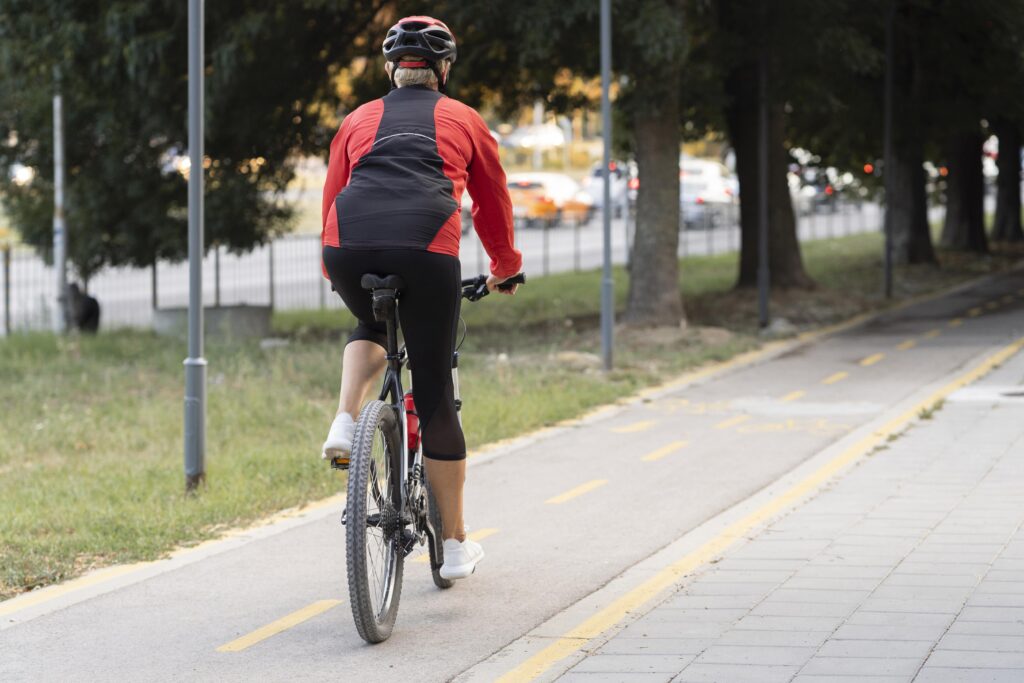Embarking on a 100-mile bike journey is not just a test of physical endurance, but a testament to the cyclist’s dedication and passion for the sport. The challenge of pedaling through such a significant distance captivates many enthusiasts, offering a blend of adventure, personal achievement, and the opportunity to push one’s limits.
This feat, often referred to as a century ride, is a bucket-list item for seasoned cyclists and a pinnacle goal for novices. As we explore how long does it take to bike 100 miles, we’ll uncover not only the physical demands but also the mental fortitude required to conquer the century ride.
Whether you’re a cycling veteran or a newcomer, understanding the journey ahead is the first pedal stroke towards success.
How Long Does it Take to Bike 100 Miles? Factors Affecting Biking Speed
There are various factors that impact the riding speed. Consider the below factors to find out how long does it take to cycle 100 miles:
Fitness level of the cyclist
The fitness level of a cyclist is a pivotal factor in determining the time it takes to bike 100 miles. A well-conditioned cyclist can maintain a higher speed over the distance, resulting in a shorter completion time. For instance, an athlete in peak condition might complete the journey in under 5 hours, while a less conditioned individual could take 8 hours or more.

Improving cycling fitness is essential for those looking to reduce their time. This can be achieved through consistent training, focusing on both cardiovascular endurance and muscular strength.
Interval training, which alternates between high-intensity bursts and recovery periods, can significantly enhance stamina and speed. Additionally, incorporating hill climbs into workouts will build leg strength and improve overall power.
Nutrition also plays a role in cycling performance. A diet rich in proteins and carbohydrates will fuel the muscles for long rides. Hydration is equally important; cyclists should drink water regularly before, during, and after their training to maintain optimal performance.
Lastly, rest is crucial. Adequate sleep and recovery days allow the muscles to repair and strengthen, which is vital for endurance activities like cycling.
By prioritizing fitness, nutrition, and rest, cyclists can improve their performance and enjoy a faster, more efficient ride over 100 miles.
Bike Type and Quality
The type and quality of a bicycle are critical factors influencing both speed and comfort during long-distance rides. A high-quality bike designed for endurance, such as a road or touring bicycle, can significantly reduce the time it takes to cover 100 miles.
These bikes are engineered for efficiency and comfort, with features like lightweight frames, responsive gearing systems, and ergonomic seating.
When selecting a bike for long rides, consider the frame material. Carbon fiber and aluminum offer a blend of lightness and durability. The gearing system is also vital; look for a bike with a wide range of gears to handle various terrains with ease.
Additionally, a comfortable saddle and a well-designed handlebar setup can prevent fatigue during extended periods of cycling.
Moreover, the bike’s aerodynamics play a role in speed. Sleek designs and minimal wind resistance can help maintain higher speeds. Wheels are another consideration; those with a larger diameter and thinner profile are typically faster and smoother over long distances.
Investing in a quality bike with these features can enhance performance, ensuring that cyclists can maintain a brisk pace without sacrificing comfort, making the 100-mile journey not only achievable but also enjoyable.
Terrain and Weather Conditions
Terrain and weather conditions are significant determinants of cycling speed and the duration it takes to bike 100 miles. Flat terrains allow for consistent speed and less physical strain, enabling a cyclist to cover the distance faster.
Conversely, hilly or mountainous landscapes require more effort and can slow down the pace considerably due to the increased resistance and need for more power during climbs.
Weather conditions also play a crucial role. Favorable weather, with mild temperatures and little to no wind, can make the ride more pleasant and help maintain a steady speed. On the other hand, strong headwinds can be a cyclist’s nemesis, demanding more energy to push forward and potentially increasing the time significantly.
Similarly, high temperatures can lead to quicker fatigue, while colder climates can cause muscle stiffness, both affecting the cycling speed.
To optimize cycling time, one should monitor weather forecasts and plan the ride accordingly. Training in various conditions can also prepare a cyclist for unexpected weather changes. Moreover, choosing routes with favorable terrains and considering the time of day for cooler temperatures can contribute to a more efficient and enjoyable long-distance cycling experience.
Average Biking Speed
The average biking speed over a 100-mile distance varies widely based on the cyclist’s experience. Novice cyclists typically average between 10-12 mph, focusing on completing the distance rather than the time taken.
Intermediate cyclists may average 15-17 mph, as they have built up endurance and skill to maintain a faster pace. Experienced riders, often exceeding 20 mph, prioritize efficiency and speed, especially in group riding scenarios where drafting can significantly increase pace.
Group rides generally result in higher average speeds due to shared workload and aerodynamic benefits. Solo riders, regardless of experience, tend to have slower averages as they face wind resistance alone.
Consistent training, proper nutrition, and strategic pacing are key for all levels to improve their average speeds over such long distances.
Breaks and Rest Periods
During a grueling 100-mile bicycle ride, taking well-timed rest breaks is crucial for maintaining stamina and ensuring safety. Integrating short, strategic pauses allows riders to replenish energy through nutrition and hydration, while also providing opportunities to assess physical condition and equipment status.
Efficient rest stops are best planned at regular intervals, preferably at points offering shelter, water, and medical aid if necessary. Riders should aim for brief stops, keeping them under five minutes to prevent muscles from cooling down.
It’s also beneficial to synchronize breaks with challenging segments of the route, using them as a reward system to boost morale. By incorporating these strategies, cyclists can optimize their performance and complete the century ride with energy to spare, all within a competitive timeframe.
This approach not only enhances endurance but also aligns with optimal cycling practices for long-distance endeavors.
Training Tips
After knowing how long does it take to bike ride 100 miles, you should prepare yourself for the rde with a structured training plan. Begin by setting incremental distance goals, starting with shorter rides and gradually increasing mileage each week.
Incorporate interval training to improve cardiovascular endurance; this involves alternating between high-intensity bursts and low-intensity recovery periods. Recovery is equally important; ensure you have rest days to allow your muscles to repair.
As the ride approaches, taper your training, reducing the intensity to store energy for the main event. Nutrition plays a pivotal role, so focus on a balanced diet rich in carbohydrates and proteins for fuel and repair.
Hydration is also key; drink plenty of fluids before, during, and after training sessions. Lastly, listen to your body and adjust your plan as needed to prevent overtraining and injury. This approach will build the stamina and strength required to successfully complete the century ride.
Nutrition and Hydration
Optimal nutrition and hydration are pivotal for endurance cyclists tackling long rides. Consuming a mix of carbohydrates, proteins, and fats ensures sustained energy, while electrolyte-infused fluids maintain hydration levels.
Start by fueling with a hearty meal rich in complex carbohydrates two hours before the ride. During the journey, small, frequent snacks like energy bars or bananas provide ongoing fuel. Hydration-wise, aim for 500-750 ml of water per hour, adjusting for weather conditions and sweat rate.
Electrolyte solutions are beneficial for rides exceeding an hour, replenishing salts lost through perspiration. Post-ride, prioritize recovery with a protein-rich snack within 30 minutes to repair muscles, and continue hydrating to replace lost fluids.
By adhering to these guidelines, cyclists can maintain peak performance and recover faster, ensuring they’re ready for their next adventure on the pedals.
Conclusion
Biking 100 miles is an achievement that hinges on diligent preparation, proper nutrition, and strategic rest. This journey, while challenging, offers immense satisfaction upon completion. It’s essential to set realistic goals, adhere to a tailored training regimen, and prioritize recovery.
Remember, the answer to how long does it take to bike 100 miles lies not just in the distance covered, but in the personal growth and joy experienced along the way. Embrace the process, celebrate each milestone, and let the love for cycling propel you towards that 100-mile mark.
With commitment and enthusiasm, this feat is not just attainable, but can also be an exhilarating adventure.
FAQs
Approximately 6,000 calories, varying with individual weight and cycling intensity.
Riding 100 miles without training is not recommended due to the physical strain and risk of injury.
A 100-mile bike ride is commonly referred to as a “Century” ride.
Yes, with adequate training and planning, cycling 100 miles in a day is achievable for many enthusiasts.



